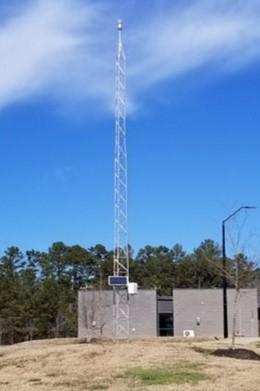This info originally appeared in the September 2022 edition of the South Wake Landfill Newsletter.
Does the landfill smell more often this time of year?

For most of the year, the prevailing winds in our area blow toward the northeast, carrying any odors that may have escaped the landfill away from most nearby neighborhoods. But that trend flips from mid-August to mid-November, when winds are more likely to blow southwest toward Forest Springs and 12 Oaks.
Those were the findings of a 2014 study that looked at seven years of local climate data, and that trend continues to hold according to measurements from the landfill's two on-site weather stations.
The study also found that high windspeeds are our friend, and data from odor reports back that trend up too. When winds blow above 7 mph, they mix with enough fresh air to dilute any odors picked up at the landfill. Low windspeeds from 4-7 mph are the most likely to carry noticeable odors to our neighbors. Winds under 4 mph allow odors to accumulate and, if low windspeeds persist, can allow those smells to slowly spread out from the landfill.
Of course, this seasonal shift is no excuse for odor issues. Wake County is committed to investing in the latest technology and implementing the best operational practices to minimize the frequency and duration of odor issues around the landfill. We just have to work a little harder this time of year when Mother Nature works against us.
And, as always, let us know if you smell something! We rely on your odor reports to identify problems at the landfill and track our odor-fighting efforts.
Does it smell more around sunup and sundown?

On days with clear skies and low winds, you may notice more odors around the landfill around dawn and dusk due to a temperature inversion.
Ordinarily, the temperature of air gets cooler and cooler the higher up you go. That's why some places in the Blue Ridge Mountains average temperatures 20 degrees lower than Wake County.
During an inversion, a layer of air forms where the temperature is warmer than the air below it. That warm layer acts like a lid, trapping cooler air near the ground and preventing circulation. Odors are also trapped when an inversion occurs around the landfill, which holds those smells closer to the ground where we're more likely to notice them.
Inversions usually happen when sunrise or sunset causes temperatures to change and there's not enough wind to circulate the air. After dawn, a warm layer can form as the sun begins to heat things up and, after dusk, an inversion may happen as the atmosphere cools and the ground radiates a layer of heat.
Fortunately, inversions usually pass in a matter of hours. The quickest fix is for high winds to stir up the air, mixing the warm with the cold and breaking up the lid. If wind speeds remain low, the sun will eventually heat the air below the inversion layer to become hot enough to escape upward and carry odors away.
Regardless of whether you suspect a temperature inversion to be at play, please submit an odor report to let us know if you smell odor around the landfill.



